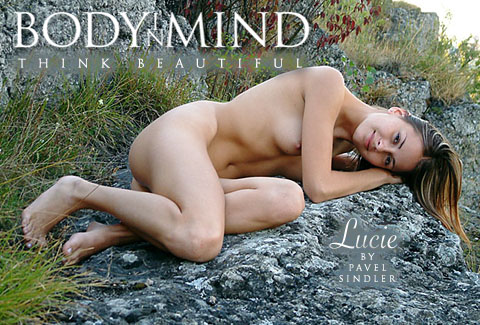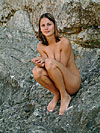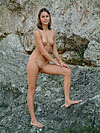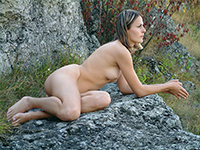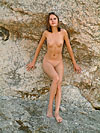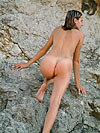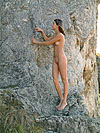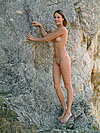HOME - MEMBERS - SEARCH - ARCHIVES - GALLERIES - LINKS - NEWSLETTER - WEBMASTERS - ABOUT US - EMAIL - NEWS - JOIN
March 25, 2005.
The true origins of Easter
by Lеаnnе Bеll
Forget what you know about Jesus, crosses, Christian rites and holidays. What you should really be celebrating this weekend is this: Easter is a kick-ass gorgeous babe.
You heard it right. Easter itself was a pagan celebration of spring long before the Christian church appropriated it and put all its dire and bloody crucifixion images on it. More than that, it was a celebration of fertility and more importantly, an homage to the life-affirming power of a woman.
What we now consider childlike Easter gimmicks such as the Eаstеr Bυnny, painted eggs and hot cross buns, all have their roots in this ancient goddess worship. Eggs are a well-established symbol of fertility, and in ancient myth represented the fertile power of the goddess. Rabbits and hares were also long considered symbols of fertility - what other animal on earth is more fertile than rabbits? Even hot cross buns - which some consider a Christian tradition at Easter - began as 'bouns', part of a ritual goddess worship. Throughout human history, springtime has always been associated with fertility, with rebirth, with love and exuberant sexuality. And what better symbol of sex, love and fertility is there than a beautiful woman?
The exact origin of Easter is a little unclear, but only because so many early civilizations held the same view of spring, fertility and women-worship, and so many had goddesses that they worshipped each spring. The most likely candidate for the origin of the Easter comes from ancient Babylonia. There the goddess worshipped was Astarte or Ishtar, the Queen of Heaven.
In ancient Sumeria and Babylon (now the modern middle east), Ishtar was the supreme goddess of a culture that afforded women equal rights with men. The writers of the bible, never pleased to see women respected, referred to her as the Whore of Babylon. In fact, she was also named Har or Hora, from which we get the words 'harlot' and 'whore'. She and her prostitute-priestesses were considered essential to harmonious existence, and each spring, a festival of beauty, joyous sexuality and pleasure was enthusiastically enjoyed by her loyal subjects. Love poems and songs of praise were constantly sung to glorify her.
In praise of Ishtar
She is clothed with pleasure and love.
She is laden with vitality,
charm, and voluptuousness.
In lips she is sweet;
life is in her mouth.
At her appearance rejoicing
becomes full
Statues and other depictions of Ishtar show a voluptuous, sensual woman, embued with all the typical allurements of sexuality and the hint of abundant fertility. She is often shown with the rising moon or sun over her head, and called the Queen of Heaven. A curious sidenote is that Christian depictions of Mary are the same. Ishtar was also called a virgin, as was Mary - though the description only applied to Ishtar's unmarried state, not her lack of experience with the opposite sex.
Surely it must be clear by now that every culture makes up stories and borrows elements from other cultures they encounter. In the myth of Ishtar, the goddess tries to rescue her son from the underworld (as the greek goddess Demeter tried to rescue her daughter Persephone from hades). Ishtar was stripped of her clothing at seven gates, until, naked at the end, she was killed by her sister and hung upon a nail. When she died, the world withered, but she was resurrected. Sound familiar?
The myth of Ishtar bears such similarity to the Christian myth of the crucifixion that it's a wonder anyone's a devout Christian these days.
Just for good measure, the myth also drifts back into the Demeter myth by saying that Ishtar's price to pay for her ressurection was to see her son live in the underworld for half the year (winter), during which time she laments and nothing grows. When he comes back in the spring, Ishtar rejoices and everything grows again.
Another explanation insists that Easter comes from "Oestre", a latin word of Greek origin that means roughly 'frenzy'. We get the English word 'estrus', meaning a female animal's mating season or 'heat' from this word. I suspect we also get 'estrogen' from it as well, with all the feminine connotations that word has. Some claim that Oestre was a druidic goddess in Anglo-Sаxоn Englаnd, and that her worshippers created the celtic holiday Beltaine, or Mаy Dаy, to celebrate her. Mаy Dаy has been observed for centuries, most notably with the Mаy Pоlе, or pole with colourful ribbons leading from it that young women would gather up and dance around. Beltaine is a time of celebration and sexuality, enjoying the release from cold winter before the harshness of hot summer.
Beltaine, or other similar spring goddess fesitvals, were full of light and fire and sun. Bonfires were common, as were candles, and throughout the world, crop growth rituals were performed such as the Macedonian tradition of young girls swinging on bowers or swings on the village green.
Whatever the festival or whatever the country, spring festivals always involved young women and a lot of fun and merriment, sprinkling or squirting water on the girls, chasing them around bonfires, beseeching them for a secretive kiss. Women were always central to the celebration, and men were given full licence to adore them openly, without shame or ridicule. Just like we do at Body in Mind.
So celebrate Easter this year - worship your own goddess and praise her to the skies.
Hаppy Ishtаr!
© Copyright 2005 Body in Mind | Photos by Pаvеl Sіndlеr
JOIN - HOME - SEARCH - ARCHIVES - GALLERIES - LINKS - NEWSLETTER - WEBMASTERS - ABOUT US - EMAIL - NEWS - MEMBERS
All contents © 1997 - 2005 Body in Mind. All rights reserved. All nude models at least 18 years old and of legal age when photographed.
